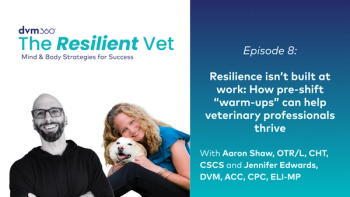
Shelter animals offer different challenges for parasite control
Dr. Kerry Muhovich discusses the special considerations practioners need to be aware of when providing parasite control for newly adopted pets.
Currently in the United States, about 20 percent of all pets are adopted from animal shelters. This small yet significant portion of the population is comprised of a diverse collection of animals from a variety of sources. While some come from homes in dry climates with few parasites, others are from climates with high humidity and a wide variety of external and internal parasites. Still others are seized from homes of hoarders where they have walked around in the filth of many other animals for weeks or even months. The environments they have inhabited and the parasite preventives and treatments they may have received are quite variable.
A shelter animal requires a parasite control that considers not only the animal's past exposures but also the new environment it will live in once it is adopted.
The following cases are designed to help you think about designing parasite prevention and control measures for patients recently adopted from animal shelters. While you may elect to do more treatments than those indicated you should always consider the efficacy of previous treatments and the potential gaps in their current protection.
Sparky
Sparky is a 1-year-old (recently) neutered male Pomeranian. Sparky was brought to the shelter's lost and found department 10 days ago by a good samaritan who found him running loose in a city park. After seven days in the shelter's indoor only lost and found facility, he was neutered and placed up for adoption. He has no signs or evidence of external parasites and has a good coat and a bright disposition. What are your potential zoonotic concerns and what parasite control measures might you recommend?
Table 1
Given that Sparky was on the streets for some amount of time and within a kennel environment for a week, we don't want to overlook the possibility of giardiasis as well as tricuriasis and ascariasis. In order to take care of all of these concerns, fenbendazole at 50 mg/kg every day for three days should eliminate the concerns. So Sparky is not overmedicated and is given the best course of treatment possible, calling the shelter to determine what previous treatments were given or having that information in writing is in order. If the shelter had already given this or a similar course of treatment, we would want to repeat the course in three months and not give anything further at this point. If they had not treated previously, we may treat now and then again in three months. While on the surface we see no external parasite concerns a thorough examination is needed to rule out fleas, ticks and possible ringworm.
Violet
Violet is a 3-year-old female domestic shorthair cat whose previous owners reportedly had her spayed as a kitten. She was relinquished to the shelter two months ago when her previous owners were moving. The previous owners did not bring in veterinary medical records when they relinquished her. They did report that she was always kept inside. A fairly comprehensive record of her stay at the shelter reveals normal firmness and appearance of stools each day of her stay. What are your potential zoonotic concerns and what parasite control measures might you recommend?
Clients with a newly adopted pet should be thoroughly interviewed about the care and parasite control program the pet received. This will help bridge possible gaps in treatment.
Provided that external parasites are not found on close examination of Violet, it appears that we have little to worry about in terms of zoonotic diseases Violet may transmit to her new family. We want to be forward thinking in Violet's care and keep in mind where she is living now in addition to where she has been. If she is now in a position to hunt or simply spend time outdoors, we want her new owner to be proactive in preventing her from being a transport system for fleas and ticks in endemic areas. A combination treatment that prevents fleas as well as ticks will help in reducing the number and types of treatments needed. The owners should also be made aware of environmental flea and tick control and the benefits of being an indoor-only cat.
Sarge
Sarge is an 18-month-old neu-tered male German Shepherd dog. He was roaming in a semi-desert rural area and picked up by animal control for that county. Two days later he was driven to a metropolitan animal shelter six hours away where the potential for rehoming of dogs is significantly higher. Several ticks were removed from him at the urban shelter and he was given a "flea bath" due to observation of some flea dirt on a flea comb run through his coat. A three-day course of fenbendazole was given at the urban shelter prior to his adoption. What are your potential zoonotic concerns and what parasite control measures might you recommend?
Table 2
We already know that Sarge had previous flea and tick exposure. Unless we see an obvious flea or tick burden a topical treatment should be enough to rid him of any residual fleas and ticks. We want to reiterate to the owner (hopefully they were told at the shelter as well) that Sarge could potentially have a tick just inside the rectum or in other body cavities where we would not readily see it. Any change to his otherwise normal appearing disposition is cause to see him back at the hospital as soon as possible. Rocky Mountain Spotted Fever may be within the realm of possibility. Following up his three-day course of fenbendazole with another course in three months would virtually eliminate our potential concerns with intestinal parasites and giardiasis. In a situation like Sarge's we want to be aware of the environment that he came from originally and be very attentive to those previous gaps in their preventive medicine history. Taking the example of Sarge and substituting a cat in the same environment, plague will likely come to the forefront of our minds. Given either a cat or a dog from a similar setting we would also need to carefully consider the vaccination history and be quite cautious about the possibility of rabies.
Lessons learned
We have now examined three different animals with three different stories: the key to their treatments -- communication and custom problem solving.
As practitioners there are a number of things that veterinarians can do to ensure their patients from shelters are not zoonotic nightmares.
- Ensure that you have the best information possible on the original source of the animal. This is of utmost importance with animals that a shelter would classify as transfers. While some transferred animals are merely from another side of the city others may be from the other side of the country.
- Report any serious health concerns directly to the director of operations of the source shelter. They will not change their treatment protocols unless they know there might be a problem with it. As always, you will need to report any reportable illnesses or serious sanitation concerns to the proper authorities.
- Tailor your treatment plan to the environment that the animal is living in now. While shelter parasite controls are standardized within a shelter, for the sake of ease and uniformity the health concerns of the people and animals of an individual household may alter your plans.
- Be aware of your local shelters' policies in regard to providing or subsidizing treatment and medications needed within the first few weeks after adoption. Shelters that do provide such services can save your client money and may help to reimburse you for your time and expenses.
- Probably most importantly, keep the lines of communication open with your local shelters. If you feel that their parasite prevention program is lacking let them know that and offer suggestions for improvement. If they already have a veterinarian on staff use that colleague as a resource. Your practice may benefit from their knowledge of parasite management and "herd health".
Suggested Reading
For additional information on shelter veterinary medicine see:
- www.hsus.org
- www.americanhumane.org
Newsletter
From exam room tips to practice management insights, get trusted veterinary news delivered straight to your inbox—subscribe to dvm360.




